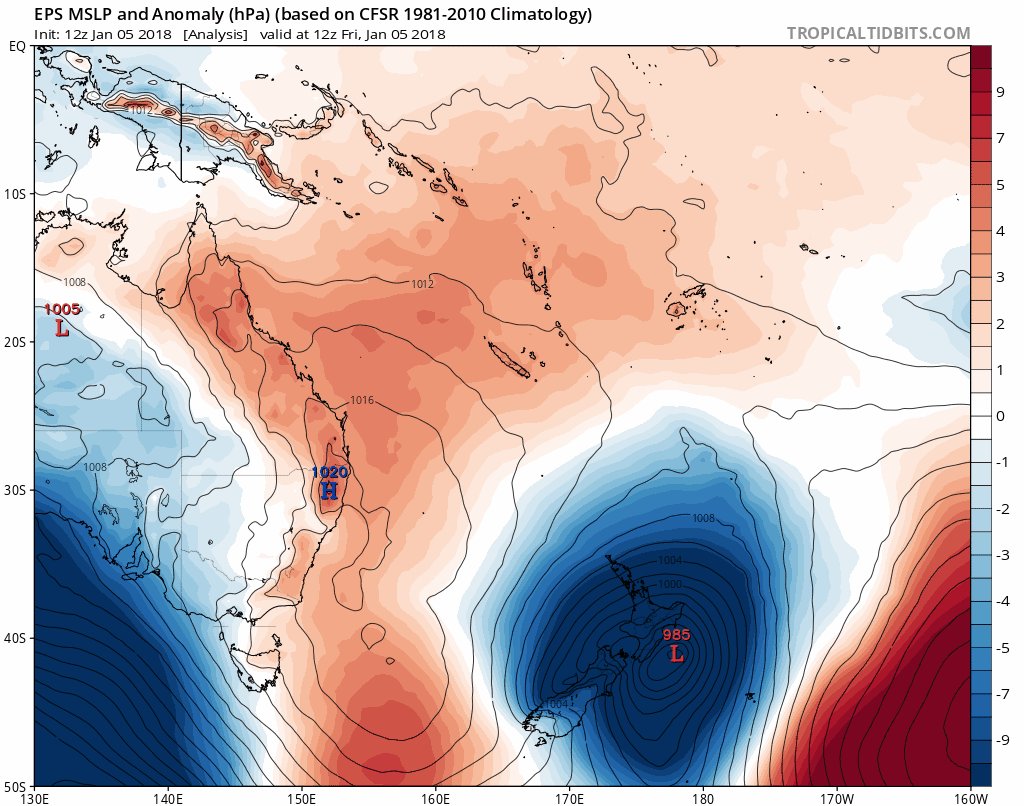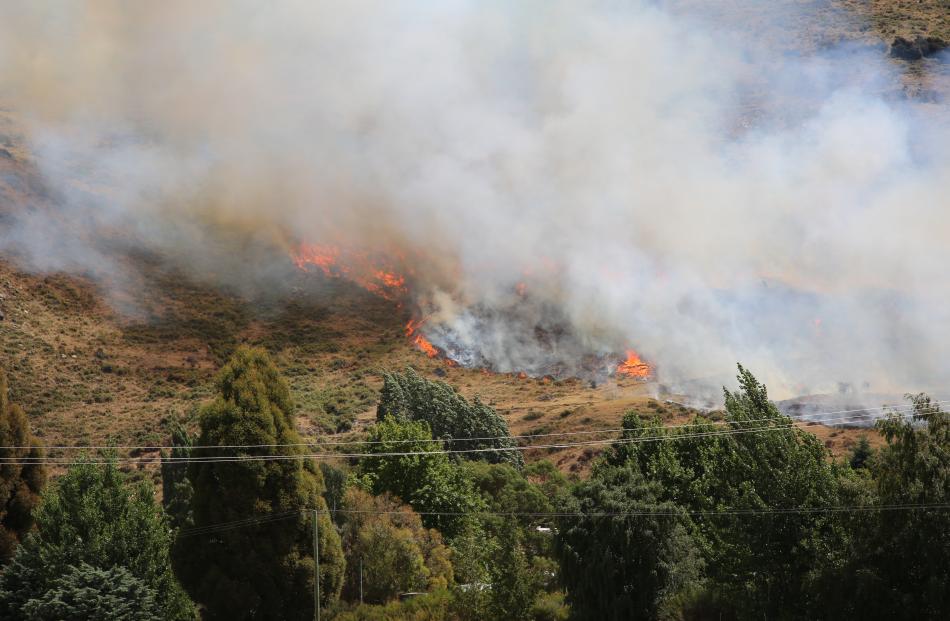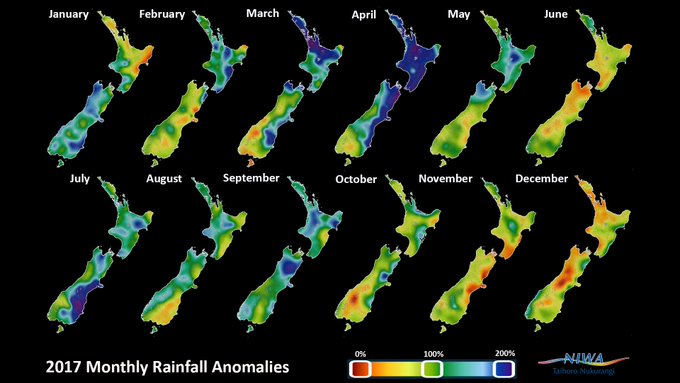Never
mind that the herd of elephants charging through the livingroom is
igored. This is ONE day's climate-related headlines for one small
country
2017
- the year extreme weather ravaged New Zealand
8 January, 2017
The past 12 months have been
marked by extreme weather with New Zealand recording its fifth
warmest year in more than a century.
Niwa today released its annual
climate summary for 2017 saying the past year was a "year of
extremes".
Annual rainfall was above
normal across the country and for some regions including Auckland,
Waikato, Bay of Plenty, coastal Canterbury and north coastal Otago,
as much as 149 per cent.
It was an especially wet year
in Oamaru which had its second wettest year on record - 813mm of rain
- and its wettest winter ever. On July 21 a whopping 161mm of rain
fell making it the wettest day in the town since records began in
1950.
At the same time the country
enjoyed higher than usual temperatures, becoming the 5th warmest year
since records began in 1909.
January was the only month
where temperatures fell below average with six months recording above
average temperatures.
April, August, September,
October and November were all between .7C to 1.3C above average with
December 2.4C above average.
How warm was 2017 in New Zealand?
The 5th warmest year on record since 1909.
The nation-wide average temp was 13.15°C or 0.54°C warmer than average.
The 4 years: 2016, 2013, 1999, and 1998 were warmer than 2017.
While sunshine was near normal
across the country Nelson was the sunniest region with 2633 hours of
sun.
Niwa described 2017 was a year
of two halves. The year started off on a west and stormy note across
the South Island in January before reaching record or near-record
rainfall and flooding across the North Island during the "Tasman
Tempest", ex-Tropical Cyclone Debbie and ex-Tropical Cyclone
Cook that swept through in March and April.
In terms of rainfall, 2017 was a year of two halves.The #TasmanTempest (March), #CycloneDebbie &#CycloneCook (April) contributed to record or near-record rainfall.
By the end of 2017, 11 out of NZ's 16 geographical regions were experiencing meteorological drought.
Later in the year parts of
western and lower North Island were in a meteorological drought as
very dry weather in November led to major decreases in soil moisture.
Niwa said Christchurch
observed just a single mm of rain during November, the driest
November on record. The city had a 47-day dry spell that was broken
mid-December.
Sea surface temperatures also
fluctuated starting off the year at normal levels but up to 4C above
average as a "marine heatwave" hit coastal waters in
November in December

Much of New Zealand is in for
a summery week with temperatures soaring to 30C but won't be
experiencing the searing heatwave scorching Australia.
Sunny skies have replaced the
tempest that blew through the country at the end of last week.
With the blue skies
temperatures are expected to soar as high as 30C in Blenheim and
Alexandra and 29C in Christchurch, Hastings and Gisborne tomorrow.

A rogue
wave has swept a vehicle into the sea at Wellington's Lyall Bay.
A police
spokeswoman said the incident was reported about 6.15pm on Sunday,
but it is not known when it happened.
The car
had been parked at a popular fishing spot near the bay sometime over
the weekend, the spokeswoman said.
The
owners of the car are aware of what happened, police say.
"The
car was parked there by the owner, and unfortunately a rogue wave hit
the vehicle and dragged it into the sea.

State
Highway 1 north of Kaikoura has been closed north of Kaikōura
after temporary sea blocks were washed onto the road.
Contractors
have been working from first light Monday trying to shift the 5-tonne
concrete blocks from the road near Ohau Point.
The
temporary sea wall is 5 metres high but is expected to be double that
when finished.

Fire
crews may be back on Mt Alpha near Wanaka for the sixth day today,
dampening down remaining hot spots from the fire that started on
Wednesday afternoon and burnt almost 200ha of hillside pasture.
Fire
Service southern communications shift manager Andrew Norris said
three ground fire crews and a helicopter with a monsoon bucket were
working on hot spots on the blackened hillside on Saturday and most
of yesterday, during daylight hours.
The
fire, which began just after 3pm on Wednesday, burnt 199ha of grass
and heather on Hillend high country station. Principal rural fire
officer Graeme Still described the fire as "very deep-seated"
and predicted it would be several days before it was completely out.
Volunteer
fire crews from around the Central Lakes district, Southland and
Mount Cook, together with helicopters from several different
companies were brought in to fight the blaze.
Yearly
rainfall was above normal across the country and for some regions
including Auckland, Waikato, Bay of Plenty, coastal Canterbury and
north coastal Otago, as much as 149 per cent.
It was
an especially wet year in Oamaru which had its second wettest year on
record - 813mm of rain - and its wettest winter ever. On July 21 a
whopping 161mm of rain fell making it the wettest day in the town
since records began in 1950.
At the
same time the country enjoyed higher than usual temperatures becoming
the 5th warmest year since records began in 1909.
January
was the only month where temperatures fell below average with six
months recording above average temperatures.
April,
August, September, October and November were all between .7 to 1.3C
above average with December 2.4C above average.






No comments:
Post a Comment
Note: only a member of this blog may post a comment.